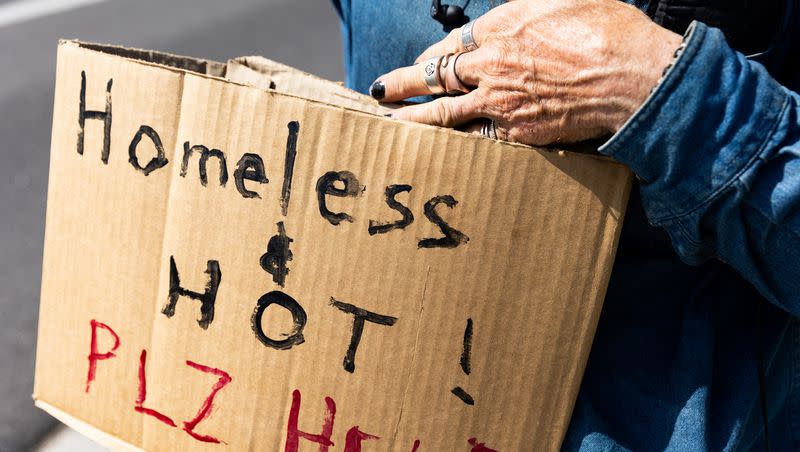Heat contributes to discomfort, illness and hopelessness among Salt Lake's homeless population

The small clusters of tents or makeshift shelters strung together with tarps fluttered at the sound of footsteps. The sweltering heat had already arrived by mid-morning with no wind in the forecast — the movement could only mean that someone was inside.
"Folks don't have access to enough water, and so they get dehydrated pretty easily, and that leaves them very vulnerable to heat stroke," said Wendy Garvin as she began to hand out plastic bags of ice and bundles of water to people emerging from their tents.
Garvin, executive director of Unsheltered Utah, and other community members have been delivering supplies to various encampments amid extreme temperatures over the past week. On a single day, Garvin reported handing out approximately 488 bottles of water. She also reported several cases of heat stroke and hospitalizations of unsheltered people due to the heat.
The heat wave swept into Utah early last week, bringing with it record-high triple-digit temperatures. The National Weather Service issued excessive heat warnings and heat advisories all across the state, and overnight temperatures stayed warm with the lows falling only to between 70 to 80 degrees.
Experts advised Utahns to take precautions to avoid heat-related illnesses by avoiding physical exertion during the hottest part of the day and staying indoors from 3-5 p.m. While the precautions may seem excessive to some, heat can be extremely deadly.
Heat-related deaths are one of the deadliest weather-related health outcomes in the United States, according to the Centers for Disease Control and Prevention. Around the country, heat contributes to some 1,500 deaths annually and homeless advocates estimate about half of those people are homeless.
Salt Lake City's homeless resource centers saw a 98.7% occupancy rate in mid-July, with fewer beds since the temporary winter overflow ended in April. The deadly heat and limited options for the unsheltered population to escape it has mobilized efforts by community members like Garvin.
"People are in enclosed tents, which gather the heat and increase that heat. What we see is although the temperatures are reading at about 100 to 103 degrees in the shade, they're running closer to 120 degrees out in the sun," Garvin said. "And so, even people who have vehicles often can't afford to keep them running to run their AC, and then the heat radiates into the metal cars and causes them to just become ovens. We just see a lot of really tough environmental challenges that are in some ways harder to fight than when it's cold in the snow."
In addition to water and ice, Garvin and volunteers have begun passing out flyers indicating where Salt Lake County cooling zones are located. The cool zones are designated areas any individual should be able to access during the day for shelter from the heat through Oct. 15.
Residents can easily locate their nearest cool zone facility by calling 385-468-3200 or by using an interactive map created by Salt Lake County. While the cool zone can provide temporary relief and is a needed program, there can still be gaps, Garvin said. The senior centers feature activities for everyone to participate in, but sitting in lobbies for hours on end can lead to restlessness or boredom. Conflicts between pets such as cats and dogs can also push people out of the programs, she added.
"They are good programs. They are spread pretty far out, so sometimes people really hit kind of a dead zone in between the different programs and don't have close access to anywhere to go," said Garvin.
But many of the unsheltered population are unwilling to leave behind their belongings, and transporting them in the heat can be dangerous. Some opt to camp on the street with their belongings and endure the heat, sometimes finding shelter near underpasses or shaded areas. Although a sanctioned campground has been discussed, current city policy prohibits camping on the streets and encampments are subject to city cleanings or abatements.
"I try to make the best of being out here as I can, but it's hard really. It's hard to move forward. It's hard to progress and take large steps in any direction because it always seems like we're spending our time and energy into protecting our stuff and we're not protecting it; it's getting thrown away," said Ryan Dustin Lee, who is currently unsheltered.
Lee pointed to a recent abatement where he had lost a tent he had purchased and medication. The medication would require several steps to refill if the pharmacy were to refill it at all.
"It gets pretty tough, not only physically but mentally and emotionally. I just find it hard to believe that in the country we're in and the state that we're in that people are left out here on the streets," Lee continued, with tears in his eyes.
After aid efforts last week, Garvin learned of a recent suicide by an unsheltered person on 500 West. "I see it as a sign of extreme conditions causing hopelessness," she wrote in a text message to KSL.com.

